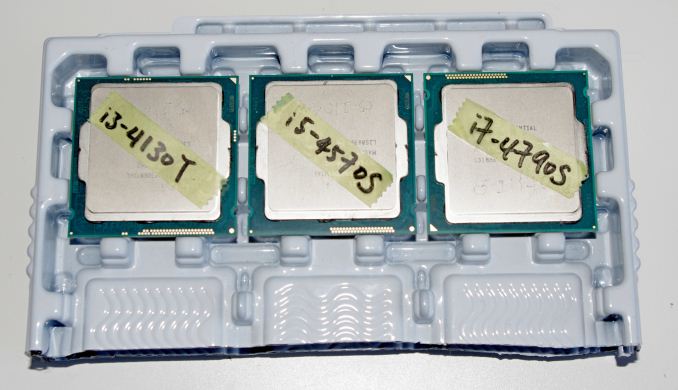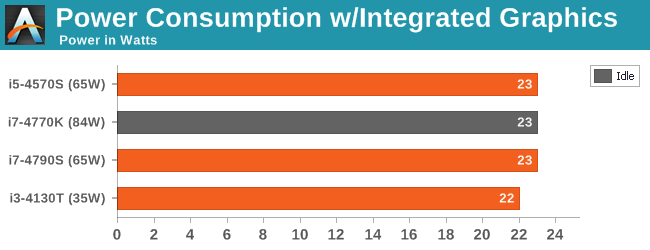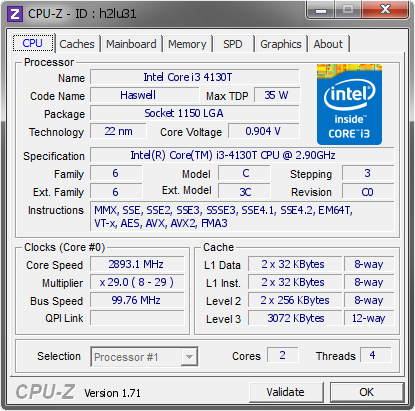Intel Haswell Low Power CPU Review: Core i3-4130T, i5-4570S and i7-4790S Tested
by Ian Cutress on December 11, 2014 10:00 AM EST
Despite being an integral part of Intel's product stack, reviews of the lower power models are few and far between. For those of us that have no interest in overclocking, the lower power parts can offer similar stock performance to the big boys but at 65W and 35W. Today we are testing three chips available from Newegg at $135, $215 and $315.
Not All CPUs are Alike
While Intel's CPU naming scheme is finally starting to make sense to home system builders, their product stack consists mainly of generic numbers in either Celeron, Pentium, i3, i5 or i7 format unless someone sits down and explains the trend to the individual. These models are clearly defined whereby a bigger number tends to mean more frequency. With this general stack of names, there are sometimes models that come with extra letters. Overclockers already know the K and the X models as having their multiplier unlocked for extra potential, but for other CPUs we have T and S destinations. (Xeons also use the letter L, and mobile chips have H/Y/U.)
Simply put, T is used for 35W/45W models and S is for 65W models. The S models tend to have similar single core performance to their normal cousins, but reach 65W by reducing the multicore frequency when the CPU is loaded. The T models reduce both single core and multicore frequency to hit their 35W or 45W, but tend to be a little more esoteric in their position in the stack.
In general there are two ways to reduce the TDP on a CPU. We can either reduce frequency (easy) or reduce voltage (difficult). Reducing the voltage results in more of a change in power consumption, but the best way to tackle this is when Intel performs its binning process.
When a manufacturer creates a wafer of CPUs, these have to be tested for accuracy of calculations, functions, and the voltage/frequency response. It is this latter characteristic which matters most when determining what product in the stack it should be. The units with the highest frequency for the lowest voltage (on a scale) tend to be reserved for the fastest processors or Xeons. Note that it is not only a single data point being tested, but a whole scale from low frequency to high frequency. The unit has to match an entire line to be sufficient for that designation. Where the low power CPUs come in is that they follow a particular line at a potentially lower voltage range than expected.
There have been reports of the regular branding of CPUs being reduced in frequency and matching the stability of the S/T processors. That is entirely possible, as a unit can be a member of many bins at the same time. At the end of the day, when you purchase a lower power processor, you are essentially guaranteed that level of performance and TDP by the processor manufacturer.
The Product Stack
To represent Intel's Haswell line-up, I want single out where the S and T processors stack up against their normal counterparts. Thus is made somewhat difficult by the Haswell refresh earlier this year which caused a frequency bump in most models, but both pre-refresh and post-refresh processors are still up for sale in most markets.
| Intel Haswell T CPUs | ||||||
| Cores / Threads | TDP | L3 | Base Frequency |
Turbo Frequency |
OEM Price | |
| i3-4130T | 2 / 4 | 35W | 3MB | 2900 | $122 | |
| i3-4150T | 2 / 4 | 35W | 3MB | 3000 | $117 | |
| i3-4160T | 2 / 4 | 35W | 3MB | 3100 | $117 | |
| i3-4330T | 2 / 4 | 35W | 4MB | 3000 | $138 | |
| i3-4350T | 2 / 4 | 35W | 4MB | 3100 | $138 | |
| i3-4360T | 2 / 4 | 35W | 4MB | 3200 | $138 | |
| i5-4460T | 4 / 4 | 35W | 6MB | 1900 | 2700 | $182 |
| i5-4570T | 2 / 4 | 35W | 4MB | 2900 | 3600 | $192 |
| i5-4590T | 4 / 4 | 35W | 6MB | 2000 | 3000 | $192 |
| i5-4670T | 4 / 4 | 45W | 6MB | 2300 | 3300 | $213 |
| i5-4690T | 4 / 4 | 45W | 6MB | 2500 | 3500 | $213 |
| i7-4765T | 4 / 8 | 35W | 8MB | 2000 | 3000 | $303 |
| i7-4770T | 4 / 8 | 45W | 8MB | 2500 | 3700 | $303 |
| i7-4785T | 4 / 8 | 35W | 8MB | 2200 | 3200 | $303 |
| i7-4790T | 4 / 8 | 45W | 8MB | 2700 | 3900 | $303 |
| Intel Haswell S CPUs | ||||||
| Cores / Threads | TDP | L3 | Base Frequency |
Turbo Frequency |
OEM Price | |
| i5-4430S | 4 / 4 | 65W | 6MB | 2700 | 3200 | $182 |
| i5-4460S | 4 / 4 | 65W | 6MB | 2900 | 3400 | $182 |
| i5-4570S | 4 / 4 | 65W | 6MB | 2900 | 3600 | $192 |
| i5-4590S | 4 / 4 | 65W | 6MB | 3000 | 3700 | $192 |
| i5-4670S | 4 / 4 | 65W | 6MB | 3100 | 3800 | $213 |
| i5-4690S | 4 / 4 | 65W | 6MB | 3200 | 3900 | $213 |
| i7-4770S | 4 / 8 | 65W | 8MB | 3100 | 3900 | $303 |
| i7-4790S | 4 / 8 | 65W | 8MB | 3200 | 4000 | $303 |
If we do direct comparison with a few of the S processors with their non-S counterparts, we see their main difference is just the multicore frequency to drive the TDP down.
| Intel Haswell S CPU Comparison | ||||||
| Cores / Threads | TDP | L3 | Base Frequency |
Turbo Frequency |
OEM Price | |
| i5-4590S | 4 / 4 | 65W | 6MB | 3000 | 3700 | $192 |
| i5-4590 | 4 / 4 | 84W | 6MB | 3300 | 3700 | $192 |
| i7-4770S | 4 / 8 | 65W | 8MB | 3100 | 3900 | $303 |
| i7-4770 | 4 / 8 | 84W | 8MB | 3400 | 3900 | $303 |
With the T processors, we see a more aggressive trend especially with the i7 range.
| Intel Haswell T CPU Comparison | ||||||
| Cores / Threads | TDP | L3 | Base Frequency |
Turbo Frequency |
OEM Price | |
| i3-4160T | 2 / 4 | 35W | 3MB | 3100 | $117 | |
| i3-4160 | 2 / 4 | 54W | 3MB | 3600 | $117 | |
| i7-4770T | 4 / 8 | 45W | 8MB | 2500 | 3700 | $303 |
| i7-4770 | 4 / 8 | 84W | 8MB | 3400 | 3900 | $303 |
The i7 35W processors have always been a fascination of mine (much like the 65W 12-core Xeon we reviewed earlier in the year). Ultimately these are best for work flow that can use multicore processing but the code has significant memory delays. This reduces the idle time per core and uses less power.
The purpose of this review is to see how these processors compare to those we have already tested. We currently have a good spread of the Haswell range, and all the results can be found in our online benchmark comparison database, Bench.
Test Setup
| Test Setup | |||||
| Processor | |||||
| Intel Core i3-4130T | 35W | 2C/4T | 2.9 GHz | ||
| Intel Core i5-4570S | 65W | 4C/4T | 2.0 GHz / 3.0 GHz | ||
| Intel Core i7-4790S | 65W | 4C/8T | 2.7 GHz / 3.7 GHz | ||
| Motherboards | ASUS Z97 Pro MSI B85M Eco |
||||
| Cooling | Cooler Master Nepton 140XL | ||||
| Power Supply | OCZ 1250W Gold ZX Series | ||||
| Memory | G.Skill RipjawsZ 4x4 GB DDR3-1600 9-11-9 Kit | ||||
| Memory Settings | 1600 9-11-9-27 1T tRFC 240 | ||||
| Video Cards | MSI GTX 770 Lightning 2GB (1150/1202 Boost) | ||||
| Video Drivers | NVIDIA Drivers 337 | ||||
| Hard Drive | OCZ Vertex 3 256GB | ||||
| Optical Drive | LG GH22NS50 | ||||
| Case | Open Test Bed | ||||
| Operating System | Windows 7 64-bit SP1 | ||||
Load Delta Power Consumption
Power consumption was tested on the system while in a single MSI GTX 770 Lightning GPU configuration with a wall meter connected to the OCZ 1250W power supply. This power supply is Gold rated, and as I am in the UK on a 230-240 V supply, leads to ~75% efficiency > 50W, and 90%+ efficiency at 250W, suitable for both idle and multi-GPU loading. This method of power reading allows us to compare the power management of the UEFI and the board to supply components with power under load, and includes typical PSU losses due to efficiency.
We take the power delta difference between idle and load as our tested value, giving an indication of the power increase from the CPU when placed under stress.

Power consumption for our i3 and i5 samples were near on the mark, whereas the i7-4790S scored 102W from idle to AVX. This is more than the i7-4770K, which might come across as a bit alarming.
We also have some full system power draw numbers from the MSI B85M ECO review, while using a Rosewill Silent Night 500W Platinum power supply. These are still in the 5% power used range for the unit, so efficiency is still around 70-80%.

Load Delta Temperature on Intel Stock Cooler
At request from some of our readers on Twitter, we also measured the temperature delta from idle to load on the stock Intel cooler.













76 Comments
View All Comments
azazel1024 - Thursday, December 11, 2014 - link
Can we also move away from having a GPU in the system for tested idle and load power consumption? It is one more source of bluring on what is actually using the power. Everything on the chart has an iGPU and in most cases businesses or low power users are going to be leaning on the iGPU, not a dGPU. So seeing what system power consumption is without a dGPU is important, even if all systems have the same contribution from an identical dGPU (it means a lot more if the dGPU is contributing 10w at idle...so suddenly you have a 3w difference between processor models...but the idle is 10w for one and 13w for another, instead of 20w and 23w).barleyguy - Thursday, December 11, 2014 - link
Delta charts are more accurate, and easier to generate, than absolute numbers. An absolute number will either be "total system power" or "total system power minus an estimate of non-processor power". The first is useless as information about the processor, because it isn't comparable across platforms, and the second is only an estimate unless hardware mods are done for power taps. For a chart that has such a large number of processors on it, the estimation errors for calculating discrete draw would likely put the chips in the wrong order.rootheday3 - Thursday, December 11, 2014 - link
For people who are using the onboard graphics, a 1250 power supply, even one that is Gold rated, is going to be pretty inefficient at low power.I know it is nice/convenient to have a single common setup for testing both with and without graphics and it makes things "apples-to-apples" but it doesn't match how I would build a system. If I really only intend to use the onboard graphics, I would try to pick a power supply that was sized appropriately.
For users trying to understand the platform/cpu idle and load power, it seems like it would be beneficial to have both idle and load power reported AND appropriately sized power supply for the test conditions.
Daniel Egger - Thursday, December 11, 2014 - link
> If I really only intend to use the onboard graphics, I would try to pick a power supply that was sized appropriately.Good luck with that. There're almost no appropriately sized PSUs for such systems available on the market; seems like they're all exclusively designed for and sold to big OEMs.
azazel1024 - Thursday, December 11, 2014 - link
Not really. The idle power of the CPU very well might be different between the different CPUs combined (which can be sussed out if they all use the same hardware configuration excepting the CPU). Idle to load might only be a 10w difference for one CPU...but it might idle using 20w for the CPU. Another CPU might be a 15w difference from idle to load, but it might idle at 5w...making it a much more power efficient CPU overall.rootheday3 - Thursday, December 11, 2014 - link
At idle, CPUs enter pkg c states and burn less than 1w regardless of sku/stepping/binningpiasabird - Thursday, December 11, 2014 - link
http://download.intel.com/support/processors/corei...It must be because intel is not selling the CPU's in boxed retail set. 4360T, 4350T, 4330T, 4160T, 4150T, 3250T are not available boxed, but are valid parts. My guess is you have to order them as tray and are only available to OEM's. However, they may be available through a small OEM custom computer builder shop.
sweetie peach - Thursday, December 11, 2014 - link
I have been using the i7-4790S for the past 4 months and there is something very strange about the results. The cinebench multithreaded bench is way too high. This cpu turbos to 3.6GHz with 4 cores so it can not possibly have the same score as a non-S that turbos to 3.8 GHz with 4 cores. Also my own average results are 160 for single and 740 for multi (HT enabled of course). Maybe there is something wrong with my setup but it doesn't feel slow in any way. It was very difficult to get hold of but it made sense because i want a very quiet computer even at load.otherwise - Thursday, December 11, 2014 - link
Do any of these support ECC? Or do you still need a sandy-bridge era i3 to get that feature?Cerb - Sunday, December 14, 2014 - link
Most, if not all, the Haswell Core i3 CPUs support ECC, as do all of the Xeon E3 V3 series.